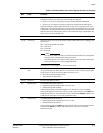
Debug
ARM DDI 0363E Copyright © 2009 ARM Limited. All rights reserved. 11-8
ID013010 Non-Confidential, Unrestricted Access
The Watchpoint Fault Address Register (WFAR) reads an address and a processor state
dependent offset, +8 for ARM and +4 for Thumb.
11.3.6 Power domains
The processor has a single power domain. Therefore, it does not support the Event Catch
Register, the OS Lock, or the OS Save and Restore functionality.
11.3.7 Effects of resets on debug registers
The processor has two reset signals which affect the debug registers in the following ways:
nSYSPORESET
You must assert this signal when powering up to set the non-debug processor
logic to a known state.
PRESETDBGn
You can assert this signal to set all of the debug logic to a known state, without
affecting the state of the remainder of the processor logic.
11.3.8 APB port access permissions
The restrictions for accessing the APB slave port are described as follows:
Privilege of memory access
You must configure the system to disable accesses to the memory-mapped
registers based on the privilege of the memory access.
Power down
The processor only supports a single power domain, therefore you must configure
the system to return an error response to all accesses made to the APB interface
while the processor is powered-down.
Privilege of memory access permission
When non-privileged software attempts to access the APB slave port, the system must ignore
the access or generate an error response to the access. You must implement this restriction at the
system level because the APB protocol does not have a privileged or user control signal. You
can choose to have the system either ignore the access or generate an error response.
You can place additional restrictions on memory transactions that are permitted to access the
APB port. However, ARM does not recommend this.
Locks permission
You can lock the APB slave port so that access to some debug registers is restricted. ARM
Architecture v7 defines two locks:
Software lock
The external debugger can set this lock to prevent software from modifying the
debug registers settings. A debug monitor can also set this lock prior to returning
control to the application to reduce the chance of erratic code changing the debug
settings. When this lock is set, writes to all debug registers are ignored, except
those generated by the external debugger, which override the lock. For more
information, see Lock Access Register on page 11-34.


















